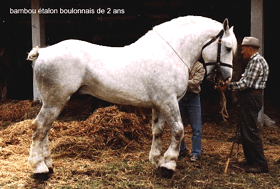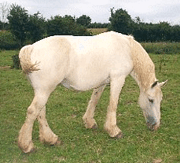//www.haras-nationaux.fr/hn0700/accueil/frame01_gb.htm

HORSES OF THE WORLD
| BOULONNAIS
Origin: |
 Photo supplied by Haras Nationaux & Udine France © |
History:
The Boulonnais originated in the north west of France where native stock
was influenced by eastern blood imported by the invading Roman armies. The returning
Crusaders brought more horses of eastern origin into the region further influencing the
breed. The noblemen Eustache, Comte de Boulogne and Robert, Comte d'Artois imported
Arabian horses to their stables to upgrade the breed. During the 14th century Mecklenburg
blood from Germany was used to produce a stronger horse able to carry the knights and
their armour.
Two types of Boulonnais developed. A heavier version often weighting more than a ton
suitable for agricultural and industrial work and well suited for the meat market and a
lighter, smaller horse, capable of light draught and farm work. In the 17th and 18th
century the smaller horse was used to carry fish from Bologne to Paris and became
known as Mareyeur or fish merchant.
The name Boulonnais was introduced in the 17th century referring to the main breeding area
with the same name on the north coast of France. This area became a major battle field in
World War I and seriously depleted the numbers of Boulonnais. World War II and the fast
spreading mechanisation also took their toll on the breed leading almost to the extinction
of the Boulonnais. Some dedicated breeders ensured the horse's survival by mainly catering
for the meat market. Sometimes the Boulonnais can be seen working on small farms.
The large, heavy Boulonnais still shows the Arabian influence in the small refined head,
the large expressive eyes and the outgoing temperament. Today government founded
studs ensure the survival of the breed. Boulonnais horses are branded with an anchor
on their neck, reflecting their coastal homeland.
Characteristics:
most elegant, heavy horse
Head: elegant, fairly short, broad head; straight profile;
wide forehead; slightly prominent eye sockets; large, bright eyes; small, erect ears; open
nostrils; small mouth (mares have a slightly longer, less heavy head)
Neck: thick, mostly arched
Shoulders: muscular; fairly prominent withers
Body: broad, straight back; broad chest; well sprung ribs;
round, muscular hindquarters
Mane and Tail: thick, short mane; thick, high set tail
Legs: strong limbs; large, flat joints; very prominent,
muscular projections in forearms and thighs; short thick cannons, no feather
Color: all shades of grey, silky coat
Height: 15.3. to 16.3.hh
Temperament: gentle, outgoing
Qualities: strong, economical, energetic, excellent gait
 Photo supplied by Haras Nationaux & Udine France © |
Today:
The Boulonnais are top drought horses and a small number can still be seen
working on small farms where they are more economical than tractors. They also feature
prominently on the French meat market. The Boulonnais make elegant harness teams.
![]()